How to fix a bathtub?
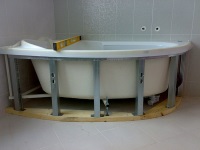
Major repairs in the bathroom involves a large front of work. As a rule, it is necessary to install a bathtub. A characteristic feature of such plumbing are large size and decent weight, especially if the bath is cast iron. That's why it is very important to fix it firmly so it won't move under the influence of human and water weight. To do this, it is worth following some rules.
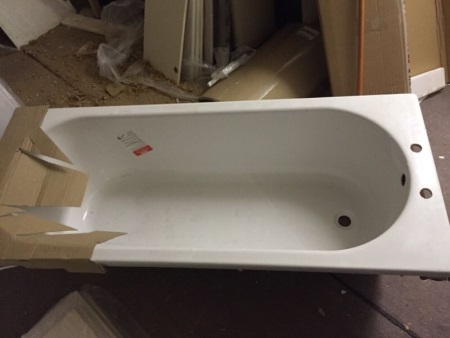
Types of fixing
If the place under the bath is prepared, all the fixing materials are purchased, then you can begin the process itself. Today, the following types of fixing the bath are available:
Mounting foam. With its help, you can securely and fairly quickly fix the tub to the floor and wall. First, the level and the required height of the device is aligned, it is connected to the water supply and sewerage. Then it is installed so that there is a gap of about 1 cm near the wall. The bathtub is filled with water for greater stability, and the gaps between the product and the legs, walls, floor are filled with assembly foam. It should be borne in mind that the foam expands somewhat, you need to use it within reasonable limits. And although it dries completely only in a day, you can finish the bath after 6 hours.
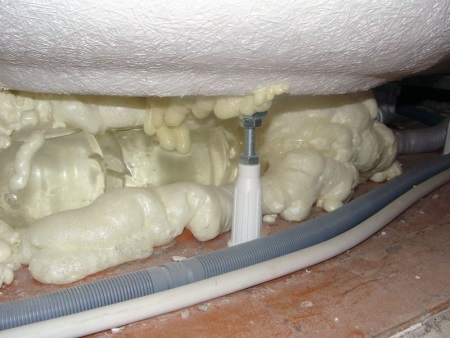
With a brick frame. As a rule, the bathtub is installed on a brick frame, when the set does not include legs. But sometimes such a frame and legs can be combined to increase the stability of the product. The brick frame can be laid across or along the tub. Masonry across provides for the installation of the product directly on the bricks. Angles are fixed to the wall with steel dowels, on which the bathtub is also placed. They play the role of additional support for the product. When masonry along the wall, the bathtub is also placed on the brick with its sides. But instead of corners, it can be fixed to the wall with assembly foam.
Bathtub can be surrounded on all sides by brickwork, which is then tiled. It is necessary to correctly calculate the height of masonry that was not necessary to cut additional tiles. The upper bricks will have to cut in half, as they simply will not fit under the sides of the bath entirely. When laying, it is better to leave a small hole through which you can inspect and adjust the siphon, if necessary. For him you can fix a small plastic door.
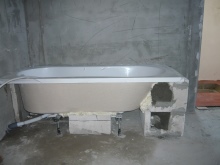
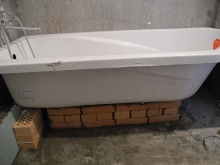
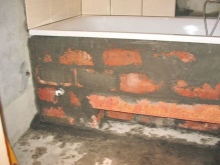
Metal frame. If the weight of the bath is low, it can be installed on a special metal frame. It can come with the main product, or bought separately. The frame is fixed to the bathtub with self-tapping screws at the places provided for this purpose, the legs are mounted. Additional stability of the bath is given by fixing bars along the wall. You need to leave a gap of about 2-4 mm when installing them, because the bathtub with water settles a bit.
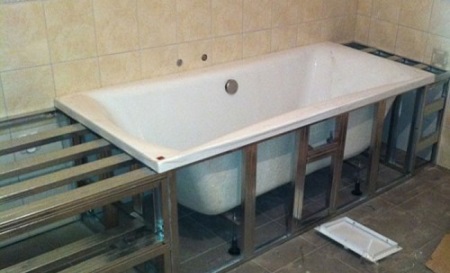
Cutting into the niche. If the bathroom is too small and it is necessary to save free space, a great option for installing the bath is to cut into the niche. Although this type of installation and the most difficult, but it provides the most reliable and rigid fixing of sanitary ware. To do this, you need to make grooves in the wall or walls with a hole punch. The sides of the bathtub are inserted into them and, if necessary, reinforced with assembly foam.
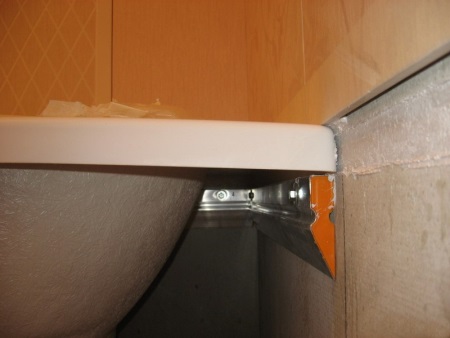
Principles of fastening
To ensure that the bathtub remains securely fixed for many years, the following principles should be followed:
- Although the cast iron bathtub is quite strong and durable, it has the greatest mass, which determines the complexity of its installation. Therefore, it is necessary to fasten it to a solid surface.
- Steel baths are often installed on a brick frame, which provides the rigidity of its attachment. To ensure that the water when filling does not make a lot of noise, the back surface of the bath can be treated with putty. As an alternative to the frame - metal legs, but they can lose their stability over time.
- Acrylic bathtubs are inexpensive and have a great appearance, but they are not the most durable. Reliable installation of such products is possible on a stable frame of metal.
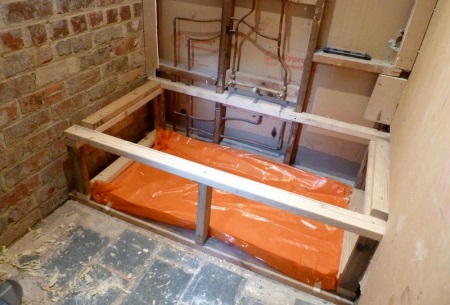
Preparation depending on the type of bathtub
Very important is the preparation of surfaces and the entire room for the installation of the bath:
Cast iron
The most important thing in fixing any type of bathtub is to measure the dimensions so that the bathtub can fit freely in the room. This refers to the length, width and height of the tub, its sides and base. Remove all old plumbing, clean the drains. Since the weight of such a bath reaches 100 kg and more, a solid surface must be prepared for it. The ideal option - it is a concrete screed covered with thick tiles. But if the screed is not the strongest, steel plates about 5 cm wide and 0.5 cm thick can be placed under the feet. If it is a bathroom in an apartment, then a reliable waterproofing of the floor is ensured.
Facing the walls is possible in two ways. They can be fully clad, and then install the bathtub, or you can clad only the top of the walls, up to the surface of the product. The latter option makes it possible to almost completely achieve no gap between the product and the wall. In this case, the tiles are laid after the bathtub has been secured.
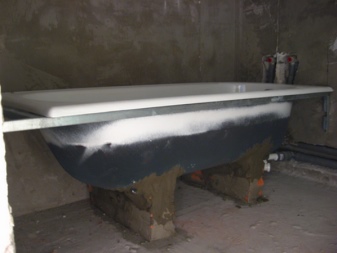
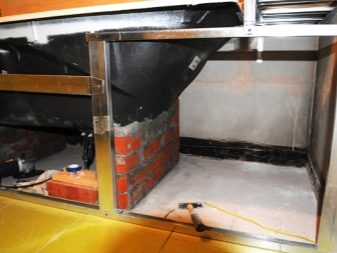
Acrylic
These tubs cannot be called the most durable products. Their surface can sag under small efforts. Therefore, experts recommend providing a sufficient number of supports. The most appropriate method of installation is a metal frame with legs. Since the weight of the bathtub is relatively small, it does not need a thick layer of concrete screed. Tiling can be done before and after the installation of the product.
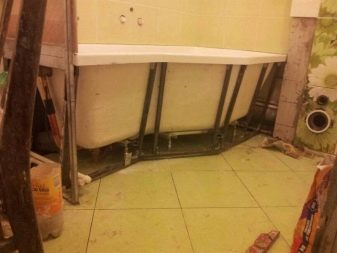
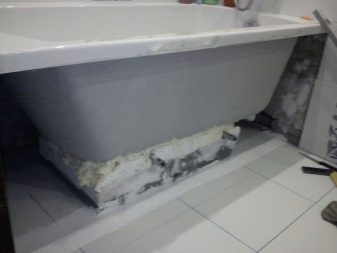
Steel
Before installing a steel bathtub, all the walls in the floor should be carefully sealed, because water can accumulate in them. The surface is treated with special waterproofing compounds. As a finish, it is better to use ceramic tiles, as it is durable and not afraid of moisture.
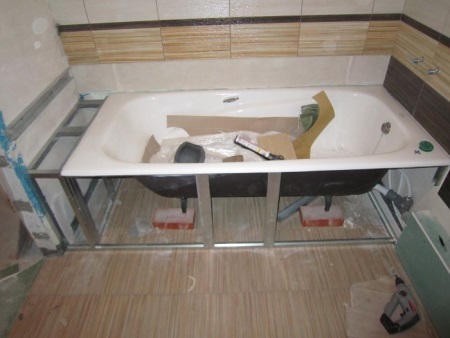
Stages of work
The process of fixing the bath depends on what material it is made of, where it is planned to be placed: along the wall or in the middle of the room. The standard process of attaching this sanitary ware to the wall is as follows:
- The first thing to connect the overflow pipe, siphon. To do this, the bathtub is turned on its side to facilitate the work.
- Bolts or self-tapping screws fix the legs, the bathtub is set on the floor so that you can connect the drainage pipe.
- The product moves close to the wall or walls.
- Place small metal plates under the feet, so that the product is slightly inclined towards the drain.
- After finally adjusting the height and position of the bathtub, the gaps between the walls are sealed with assembly foam or cement mortar.
- Close the space under the bathtub can be brickwork, which increases the rigidity of its attachment, or special plastic screens.
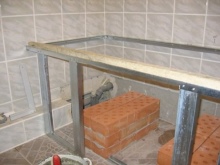
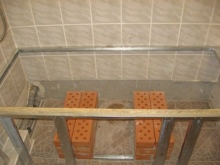
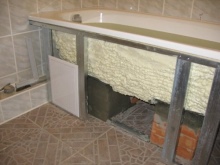
Tips
If you do not want to hire a specialist to install the tub, you should pay attention to the following tips:
- The installation of a whirlpool bathtub requires an outlet. It must be earthed and have a lid to protect it from water.
- To ensure good drainage of water from the bowl of the product, it is recommended to use a corrugated hose. It can be easily bent or stretched, it is quite durable and inexpensive.
- Select the bath should not only depend on the material, but also on the interior of the entire room. For this purpose, you can use themed ceramic tiles or plastic panels.
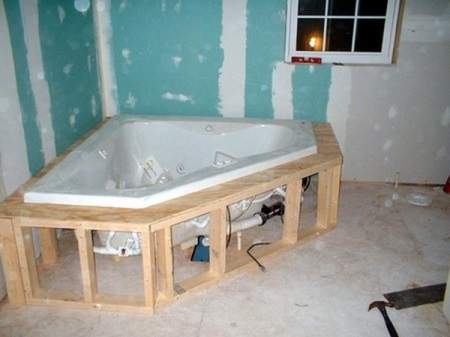
Thus, fixing the bathtub depends on many criteria, including the type of installation and material. But in any case, it is possible to securely fasten it by yourself with minimal skills in working with tools.




